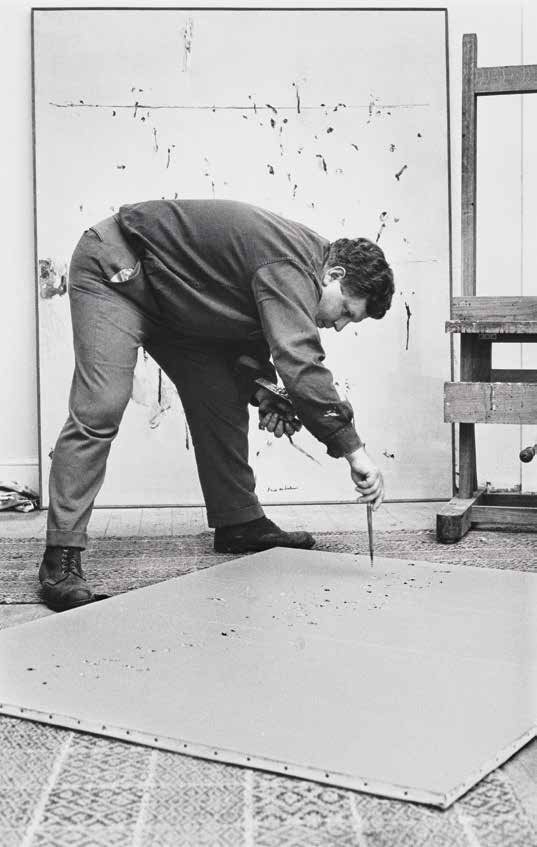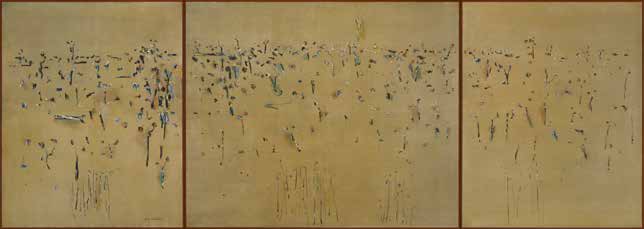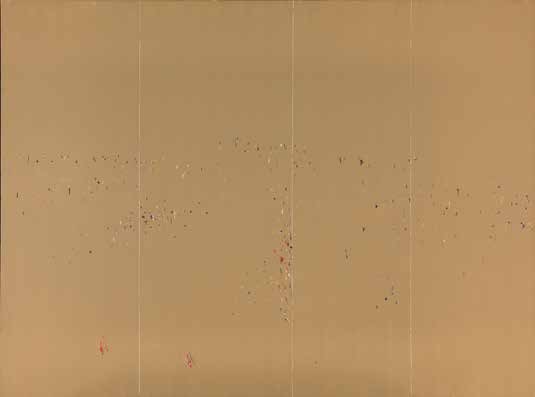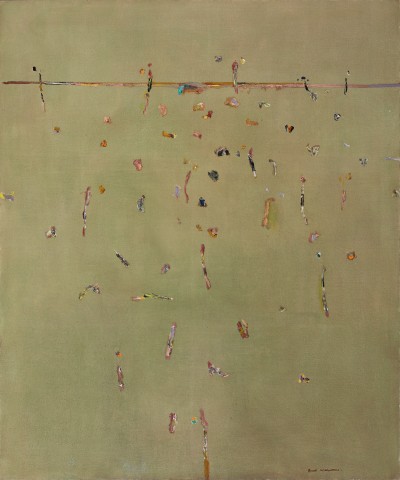LYSTERFIELD LANDSCAPE, 1968 – 69
FRED WILLIAMS
oil on canvas
182.5 x 152.5 cm
signed lower right: Fred Williams.
Estate of the artist
Marlborough Fine Art, London (label attached verso)
Joan Clemenger AO and Peter Clemenger AO, Melbourne, acquired from the above in October 1996
Fred Williams (1927 – 1982), Marlborough Fine Art, London, 1 November – 2 December 1995, cat. 4 (illus. in exhibition catalogue)
McCaughey, P., Fred Williams, Murdoch Books, Sydney, 1996, pl. 66, pp. 152, 155 (illus.), 184 (as ‘Lysterfield Landscape, 1967 – 68’)
1 williams 3.jpg

If Fred Williams’ You Yangs paintings from 1962 were to secure his reputation as Australia’s preeminent landscape artist, the work which ended the decade gave us a painter of perpetual inventiveness – one never prepared to settle into a stylistic cul-de-sac as a consequence of strong critical acclaim. A masterpiece from the zenith of Williams’ career, Lysterfield Landscape, 1968 – 69 eloquently attests to this legacy as one of the most visionary painters of his time – a unique artist unable to be placed within any movement or singular ‘school’ of thinking.
With the firming of his reputation the sixties became a particular marker for Williams. Later it came to be regarded as his essential decade – a familiar art historical characteristic – the wish to settle on a defining period and to see other work as foregrounding or following it, a period which becomes an enduring reference point. The Heidelberg School painters between 1885 – 95 are an obvious example, Sidney Nolan too in the 1940s.
A familiar Williams quote states, ‘I see things in terms of paint, all else is irrelevant’; this is certainly true but requires a fuller explanation. Williams’ sharpness of observation and alertness to subtle inflections defined his pictorial syntax. Despite descriptions of him making much out of the drabness of the bush, Williams didn’t see ordinariness. He was happiest on location, and equally so in the studio, where a reflective and considered setting allowed his intellectual disposition to take over: ‘…the knowledge that a painting must be conscious of itself, aware of its own nature and its own vocabulary, conscious of its own coding process.’1
We are familiar with the artist’s rapid gouaches; quickly painted and sharply observed then rested in the mind’s eye as a visual aide-mémoire. In the Clemenger Lysterfield we see the gouaches playing the role of second violin in a fully orchestrated masterpiece: it is a rare painting as the few complementary works of such monumental scale from this period are in public collections.
Williams kept a mainly unbroken diary, and references to specific works appear infrequently. However this is not the case with Lysterfield. He began the painting in his Upwey studio, and on 12 November 1968 notes: ‘…an early start and I go well. An underpainting of a 6 x 5…’ The entry includes a small sketch. By the time of the second reference to Lysterfield he and the family had moved to Hawthorn, and again on 7 May 1969 Williams writes, ‘This underpainting is beautifully hard and I work well on it… it goes well with the one in the Commonwealth collection. A good step forward I hope.’ The Commonwealth painting he refers to is the celebrated Lysterfield triptych, 1967 – 68 in the collection of the National Gallery of Australia.2
The ideas and sharp art historical awareness which underpinned his working approach arose from looking at work by artists with distinctive technical ranges, and who often worked in a variety of media. Williams too was comfortable painting while making superb prints, each referencing and supporting the other.
1 williams.jpg

While his years in London between 1952 – 56 (including study at the Chelsea School of Art) were to shape his future, his time at the National Gallery School, Melbourne, then tucked at the back of the Gallery’s grand Swanston Street entrance, was also influential. Visual encounters were applied to full effect. Corot’s The bent tree (L’Arbre penché), c.1855 – 60 (National Gallery of Victoria) for example, helped settle the compositional arrangement of works such as Fallen Tree, 1962 and Landscape with bent tree, c.1959 (both in the collection of the Art Gallery of New South Wales).
Williams’ swiftly executed, wet-loaded brush watercolours from his London years shifted from a muted darkness of the English landscape to translucent Cézannesque half-tones and overlapping soft washes; by 1962 they anticipate a further lightness and subtlety of surfaces which would reach their sophisticated height by the end of the decade. His oil paintings from the late fifties to the end of the sixties are rich in glazes, techniques studied in the collections at the NGV and London’s museums and later in Venice where glaze upon glaze left its mark.
In 1963 he and his wife, Lyn, moved to Upwey, a short distance to locations titles with which we are familiar, including Lysterfield, Sherbrooke, Kallista. Awarded the Helena Rubenstein Scholarship in the same year he travelled to Europe a year later. He bought rolls of canvas in London and had them shipped to Australia and painting on board all but ended.
1 williams 2.jpg

Now paint and glazes are pushed into the weave of the canvas as layers of wet on wet and drying paint become a field for immediate impasto calligraphic gestures. In the familiar ochres and browns from the late 50s to the You Yangs paintings, many have found the so-called monotony of the Australian landscape rejuvenated through Williams’ observation, jolting our visual complacency. Williams certainly didn’t see drabness. The depth of his subdued palette and the use of black and coloured accents were always an evolving part of his work. The landscape which inspired him was not repetitive, let alone uninteresting. Williams’ vision might have shaken many out of their preconceptions of the bush landscape.
The all-over gestural effects in the mid-60s hold a similar expressive immediacy to that of the important American abstract expressionist, Sam Francis, who he met in London. Williams maintained his interest in American abstraction and later, colourfield formalism.3
Matisse remained a discreet and enduring exemplar in the use of colour and in Lysterfield we see it personalised, no more so than the simple painted accent, lower centre, where viridian green and orange are juxtaposed. When half tones appear elsewhere other coloured accents invoke the palette and colour combinations of Matisse, including the use of black as a compositional device to settle and hold the minimalist pictorial arrangement. While the painting might appear to us as spontaneous and the result of an inspired moment of realisation, it took many months to reach its complete status.
As Williams’ painted marks became more pronounced and the surfaces open and sparse a particular ‘handwriting’ became an emblematic characteristic: no more so than in Lysterfield Landscape. It is a term often applied to describe his works from the mid-60s. Yet it seems colloquially self-effacing. Calligraphy is sometimes used as a catch-all but seldom explored further.
While it can be seen as handwriting – or a kind of personal mark making – calligraphy is a more accurate and authoritative description. In Chinese and Japanese culture calligraphy is an art form of the highest aesthetic consequence and meaning: and we should see Williams in the same light. In the photograph by David Moore, Fred Williams, 1969 (National Portrait Gallery), we see the artist working, not at the easel in the background, but on the floor where the method not only evokes a sense of Pollock or Sam Francis, but with its surface flat, it also emulates Chinese and Japanese artists in its physical execution.
As a student Williams saw and admired Asian art, then mainly Chinese, in the collection of the National Gallery of Victoria and later at the British Museum. At the time Williams’ Lysterfield works were painted the writer, Craig McGregor, cited this as a central influence, ‘…Williams thinks the Chinese are the best landscape painters… as he says… “everything is dropping out of the frame, tumbling out Chinese fashion.’’’4
James Gleeson was also clear in his interpretation of Williams’ masterly complexity, ‘…the sparseness and refinement of the style… restraint and sophisticated simplicity… suggest a strong influence from Japan… only if you know the place they hold in his work… can they interpreted as landscapes… his latest attempt to translate the Australian scrub into works of art.’5
As Gleeson suggests, if the horizon line were not such a defining element in Lysterfield Landscape and if we were unaware of Williams’ preoccupation with landscape, calligraphic abstraction is the only possible conclusion viewers might draw. Perhaps this explains in part the international interest in his work. A new generation of Australian abstractionists also admired Williams’ work; Robert Jacks accompanied him on painting excursions to the You Yangs, and Margaret Plant regarded work from this period ‘…to be as contemporary as The Field though more modestly scaled’.6
Lysterfield Landscape is a masterwork where Williams’ is at his most withheld, subtle and sophisticated. Paintings such as Australian Landscape III, 1969 (Queensland Art Gallery ǀ Gallery of Modern Art) and Lysterfield triptych 1967 – 68 (National Gallery of Australia) employ a sequential format with white vertical screen-like separations across a horizontal canvas, where a calligraphic ensemble of painted gestures flit across the surface.
The vertical format and scale of Lysterfield Landscape, the sublimely worked surface, considered calligraphic marks and the distinctive high horizon line create both the sensation of the landscape as its source and a work acutely aware of painting’s history across cultures as well as contemporary trends.
1. Plant, M., ‘Tribute to Fred Williams’, Art Journal, no. 23, National Gallery of Victoria, May 1982
2. Lyn Williams, conversation with the author, July 2022.
3. Sam Francis 1923 – 1994, American Abstract expressionist with a long interest in Japan, its art and culture. The Idemitsu Museum of Arts, Tokyo, holds 160 works – the largest single collection of his work.
4. McGregor, C., In the Making, Thomas Nelson Australia, Melbourne, 1969, p. 107, cited in Hart, D., Fred Williams: Infinite Horizons, National Gallery of Australia, Canberra, 2011, p. 101
5. Gleeson, J., ‘Scrub and the field of art’, The Sun-Herald, 9 November 1969, p. 115
6. Plant, op. cit.
DOUG HALL AM
